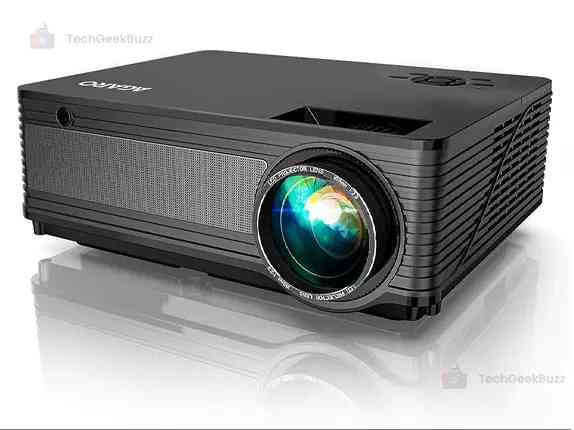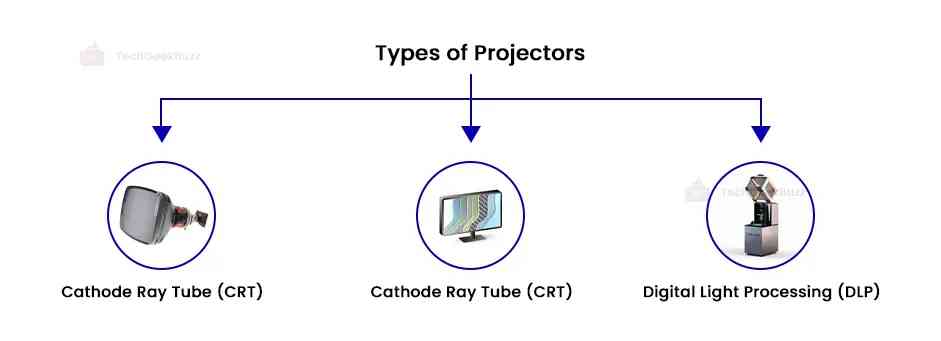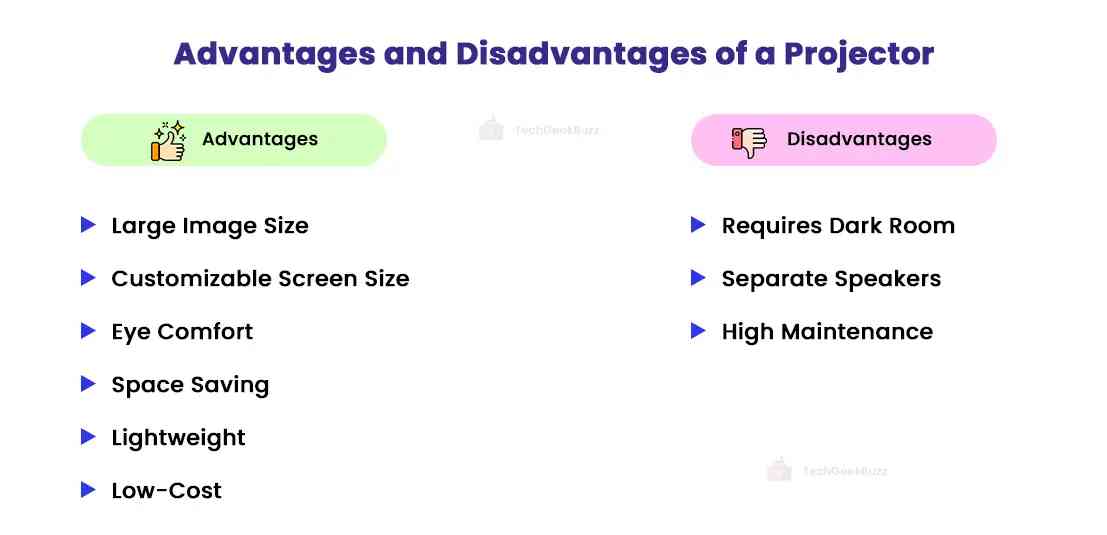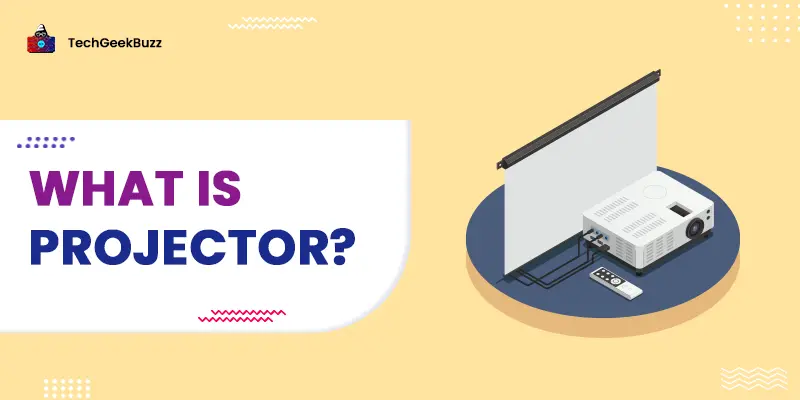You might have come across the term projector in your school days. Your teacher might have used a projector to improve the teaching-learning process. Besides classrooms, a projector can be used in entertainment venues, such as theatres. Businesses and companies leverage projectors for meetings. The applications of a projector are limitless.
But what exactly is a projector?
A projector is one of the most common output devices of a computer to display visuals generated by a computer or Blu-ray player on a large wall, screen, or other specific surfaces.
If you want to dive deeper into the nitty-gritty of a projector, continue reading this article.
What is Projector?

A projector, also known as an image projector, is an optical device that projects visuals (images, a piece of film, diagrams, etc.) on a large surface called a projection screen. It takes images or any other visuals from a computer or a Blu-ray player and projects them on a flat surface, like a wall, a big screen, a white screen, etc.
Blu-ray Player: It is a standalone device that plays Blu-ray disks and DVDs.
Projectors can replace monitors and televisions when there is a need to present visuals to a large number of people. Some projectors have a small transparent lens that projects images by shining light through it. Most modern projectors directly project the images using lasers.
A variety of projectors are available out there. The most common types are video projectors. They have replaced traditional projectors, such as slide projectors and overhead projectors. Today, handheld projectors are gaining popularity. They use lasers or LEDs to project images.
Generally, projectors are portable, with a few inches tall and a foot wide. Ceiling-mounted projectors are generally large in size, something around 30 feet long. Many projects also support WiFi and Bluetooth connectivity, while some have several ports, like VGA and HDMI, for different devices.
How Does a Projector Work?
A projector works with three primary components – the light source, condenser system, and plane mirror.
A Condenser System
The condenser system comprises a condenser, an auxiliary condenser, a threaded lens, and glass.
Two flat plexiglass plates with concentric circular threads make up the threaded or Fresnel lens. It has a very large diameter and is commonly used as a concave lens. It is lightweight and has a strong light transmission. The major setback of the Fresnel lens is that it operates only at temperatures below 70 degrees.
As a result, the auxiliary condenser is sandwiched between the light source and the condenser to cool down the Fresnel lens. Further, this lens has the object glass mounted on it, which serves two purposes:
- Display the projections.
- Write the projection film.
Here is how a projector works:
- The light comes from the light source and passes through the condenser system.
- The condenser system condenses the light and emits it onto the plane mirror.
- Further, the plain mirror converts horizontal light into vertical light.
- Finally, this light is reflected into parallel light, where it is mapped onto the projection screen.
This completes the projection function.
Types of Projectors

The three major types of projectors are – the Cathode Ray Tube (CRT), Liquid Crystal Display (LCD), and Digital Light Processing (DLP).
Let us discuss each type in detail below.
1. Cathode Ray Tube (CRT)
A CRT projector is a video projector, which is the most common type of projector used widely. It leverages the cathode ray tube (CRT) as the light-generating medium.
- This type of projector places a lens in front of the cathode ray tube to enlarge images to be displayed on the projection screen.
- Traditional CRT projectors had a single-color cathode ray tube.
- However, modern CRT projectors today have colored cathode ray tubes (red, green, and blue).
- Each of these colored CRTs has its own lens to generate colored images.
- By combining these three colors, CRT projectors are able to produce colored images of different proportions and dimensions on the screen.
However, the major drawback of CRT projectors is they consume a lot of electricity. Also, they are not portable due to their sizes. Though CRT projectors project excellent-quality images, many users find it challenging to set up.
2. Liquid Crystal Display (LCD)
A liquid crystal display (LCD) projector depends on liquid crystal displays, which are flat-panel displays using liquid crystals. Liquid crystals inside LCDs display images, videos, and any other visuals on the projection screen.
LCD projectors are known to project brilliant-quality visuals, and that too at a lower price. Hence, they are more popular than other types of projectors. More importantly, they are smaller in size compared to CRT projectors. LCD projectors are found primarily in business meetings, presentations, and seminars.
3. Digital Light Processing (DLP)
Digital Light Processing (DLP) projectors are useful in front and rear projections. These projects are classified as one-chip and three-chip projectors. While a one-chip projector can generate 16 million colors, three-chip projectors produce over 35 trillion colors.
DLP projectors are commonly found in classrooms and organizations for front projection and in televisions for back projection.
Front vs Rear Projection
- Front projection implies projecting visuals on the front of the screen. Rear projection refers to producing images on the back of the screen.
- The rear projection uses a semi-transparent gray screen, while the front projection leverages a non-transparent white screen.
- In front projection, the images are sent to the projection screen from the front of the audience.
- In the rear projection, the images are sent to the projection screen from the back.
- The rear projection is less affected by the ambient light. Hence, it projects visuals with better contrast.
- Front projection is utilized where there is a space constraint. On the other hand, rear projection requires a lot of space.
Uses of Projectors
Projectors are commonly used in educational institutes, organizations for meetings, and theatres. The following are some of the major uses of projectors:
1. Education and Classrooms
Projectors are often used in classrooms for teaching purposes. Visuals are more attractive and easy to remember than text-based content. Hence, using projectors can improve the learning process. Students can grasp concepts easily. In addition, it becomes easy for instructors to teach concepts with the help of slides and videos.
2. Home Theatre
Earlier, projectors were only used at theatres for projecting films on a large screen to provide an amazing experience. With advancements in technology, the size of projectors has reduced considerably, and they are used at homes. They have made it easy for people to enjoy films on walls and screens at home.
Projectors that are used as a home theatre are available in different aspect ratios, as follows:
- Letterbox (1.85:1)
- Video (4:3)
- Cinema (2.35:1)
- Square (1:1)
- HDTV (1.78:1)
- NTSC (1.33:1)
In addition, most of these projectors support various input sources and WiFi and Bluetooth connectivity.
3. Advertising and Art Installation
You might have seen digital advertising boards on the roads. They use projectors to display the desired visuals and information. Businesses use projectors to promote their brands and reach a wide range of audiences. They use gigantic computer screens with bright lights to attract people. Furthermore, artists leverage projectors to showcase their art installation projects.
4. Professional Theater
The use of projectors in professional theatres is pretty old. They are called film projectors. Traditional film projectors were able only to project images and moving pictures on a silver screen. However, the advent of movies and talkies has led to the display of films in different colors. Film projectors are less prone to failure due to their high degree of stability.
Advantages and Disadvantages of a Projector
Though projects offer many benefits, they have disadvantages, too. Let us now discuss some major advantages and disadvantages of a projector.

Advantages
- Large Image Size
Projectors magnify images in comparison to computers and laptops. Hence, they are widely used in classrooms, business presentations, meetings, home theatres, etc. Also, they need very less light and generate immersive visuals.
- Customizable Screen Size
Projectors produce images on a variety of surfaces, such as whiteboards, walls, etc. You can adjust your projector to any screen size. This makes a projector a flexible solution compared to televisions, which are of fixed sizes.
- Eye Comfort
Large image sizes provide more comfort to the eyes, as they are visible from afar. Images of small sizes put a strain on the eyes when you see them from a significant distance. In the case of letters, small letters are difficult to read, while larger ones are easy to comprehend.
Additionally, projectors use reflected light to project visuals, unlike televisions that use emitted light. Reflected light provides more comfort to the eyes than the emitted light.
- Space Saving and Lightweight
Generally, projectors are set up on a shelf, bookcase, or on the ceiling. As a result, they do not eat up space on the floor. In addition, modern projectors are lightweight, ranging between 2 and 20 lbs. Both of these are not the case with televisions. In addition to taking up more space on the floor, they are also relatively heavier.
- Low-Cost
Today, projectors are available at lower prices than in their early days. However, it is important to note that projectors are available according to the use cases. For instance, if you want a projector for your home to enjoy a theatre-like experience, you need to buy a specific projector.
Disadvantages
- Dark Room
The dark room is necessary to make visuals projected by a projector visible to users. This means no projectors work in a low-light setting. As a result, you need to adjust your room, office meeting room, or classroom such that minimal light enters.
- Maintenance
Projectors are high-maintenance devices compared to TVs. It is important to regularly check a projector and repair or replace components in case of failure.
- Separate Speakers
Video projectors offer low audio, making them unsuitable for watching films, lectures, and videos. Therefore, you need to install an external speaker to enjoy high-quality audio.
Conclusion
Here ends our discussion on a projector. It is an optical output device that projects visuals (images, videos, presentations, etc.) on larger screens, such as walls, whiteboards, etc. It connects with a computer or Blu-ray player and magnifies images generated by them on a large screen.
Projectors are primarily used in classrooms, office meetings and presentations, home theatres, and large theatres. Over time, they have significantly improved. Now, they are available in a compact size, light in weight, and lower cost.
People are also reading:


![What is an Assembler? [Definition, Working, & Types]](/media/new_post_images/What_is_Assembler.jpg)
![What is I/O? [Types, Examples, & Methods]](/media/new_post_images/What_is_I_O.webp)

Leave a Comment on this Post